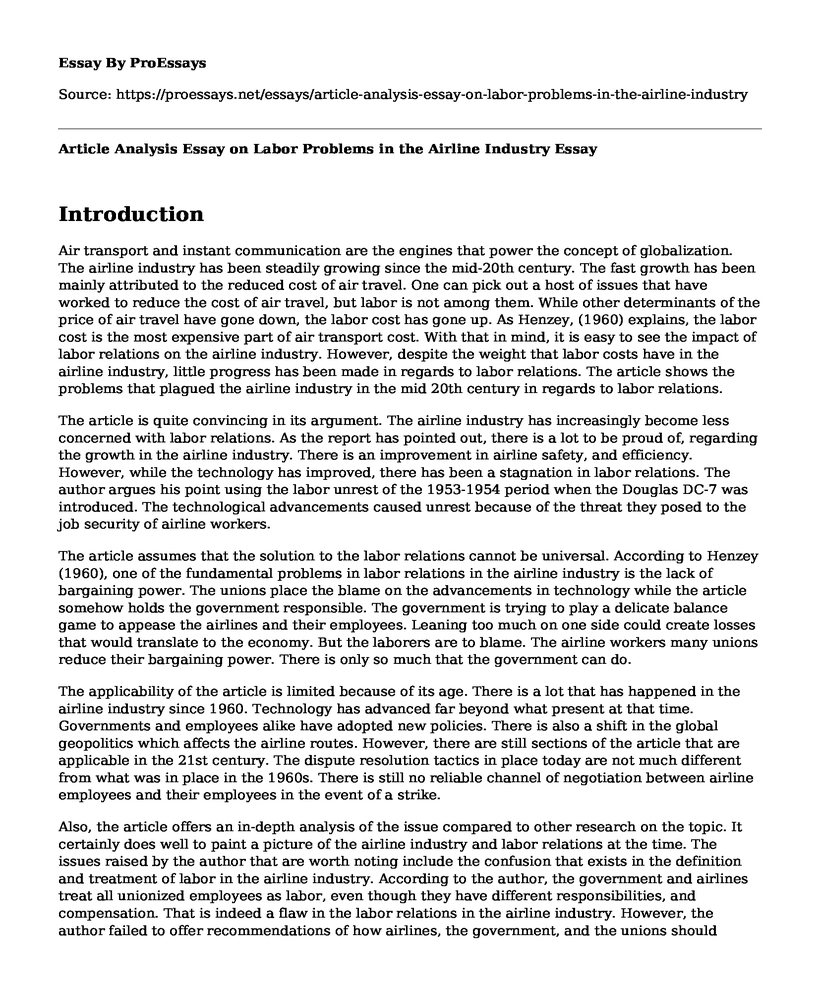Introduction
Air transport and instant communication are the engines that power the concept of globalization. The airline industry has been steadily growing since the mid-20th century. The fast growth has been mainly attributed to the reduced cost of air travel. One can pick out a host of issues that have worked to reduce the cost of air travel, but labor is not among them. While other determinants of the price of air travel have gone down, the labor cost has gone up. As Henzey, (1960) explains, the labor cost is the most expensive part of air transport cost. With that in mind, it is easy to see the impact of labor relations on the airline industry. However, despite the weight that labor costs have in the airline industry, little progress has been made in regards to labor relations. The article shows the problems that plagued the airline industry in the mid 20th century in regards to labor relations.
The article is quite convincing in its argument. The airline industry has increasingly become less concerned with labor relations. As the report has pointed out, there is a lot to be proud of, regarding the growth in the airline industry. There is an improvement in airline safety, and efficiency. However, while the technology has improved, there has been a stagnation in labor relations. The author argues his point using the labor unrest of the 1953-1954 period when the Douglas DC-7 was introduced. The technological advancements caused unrest because of the threat they posed to the job security of airline workers.
The article assumes that the solution to the labor relations cannot be universal. According to Henzey (1960), one of the fundamental problems in labor relations in the airline industry is the lack of bargaining power. The unions place the blame on the advancements in technology while the article somehow holds the government responsible. The government is trying to play a delicate balance game to appease the airlines and their employees. Leaning too much on one side could create losses that would translate to the economy. But the laborers are to blame. The airline workers many unions reduce their bargaining power. There is only so much that the government can do.
The applicability of the article is limited because of its age. There is a lot that has happened in the airline industry since 1960. Technology has advanced far beyond what present at that time. Governments and employees alike have adopted new policies. There is also a shift in the global geopolitics which affects the airline routes. However, there are still sections of the article that are applicable in the 21st century. The dispute resolution tactics in place today are not much different from what was in place in the 1960s. There is still no reliable channel of negotiation between airline employees and their employees in the event of a strike.
Also, the article offers an in-depth analysis of the issue compared to other research on the topic. It certainly does well to paint a picture of the airline industry and labor relations at the time. The issues raised by the author that are worth noting include the confusion that exists in the definition and treatment of labor in the airline industry. According to the author, the government and airlines treat all unionized employees as labor, even though they have different responsibilities, and compensation. That is indeed a flaw in the labor relations in the airline industry. However, the author failed to offer recommendations of how airlines, the government, and the unions should handle labor relations.
Conclusion
The author makes good use of examples to put his point across. The article doesn't pick a side or place the blame on any party involves. Instead, the article discusses and analyzes the issues that plagued labor relations in the airline's industry. As a result, it is up to the reader to understand the problems and come up with conclusions. The issues of technology, over unionization and generalization, have been given in-depth and thorough discussion, which translates to a well-analyzed article.
References
Henzey, W. V. (1960). Labor problems in the airline industry. Retrieved from Duke Law: https://scholarship.law.duke.edu/cgi/viewcontent.cgi?article=2822&context=lcp
Cite this page
Article Analysis Essay on Labor Problems in the Airline Industry. (2022, Dec 07). Retrieved from https://proessays.net/essays/article-analysis-essay-on-labor-problems-in-the-airline-industry
If you are the original author of this essay and no longer wish to have it published on the ProEssays website, please click below to request its removal:
- Essay Sample on Globalization & Int'lization of Economies: Socio-Cultural, Political & Institutional Aspects
- Former Employee Alleges TransCanada Unsafe Practices - Essay Sample
- Essay Sample on Economic Markets: Trading Goods & Services
- Staff Shortage in Healthcare: Examining the Problem and Evidence - Essay Sample
- Employability: Impact of Enterprise & Graduate Skills - Research Proposal
- Autonomous Vehicle Industry: Decades of Research Leads to Safer, More Efficient Transport
- Essay Sample:The Great Recession's Impact on People with Disabilities







